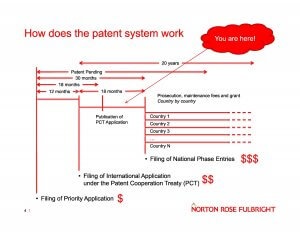A Case Study in Patent Development
Event held on Thursday, April 12, 2018
On Thursday TQT hosted a Lunch and Learn about patent development. Our speaker was Alexandre Daoust, a partner at Norton Rose Fulbright. Daoust’s presentation laid out the procedure for obtaining a patent, using one of his own – a revised method of vectorial magnetometry – as a case study.
In his talk Daoust explained the patent process’ criteria: validity, coverage, and freedom to operate. Validity is a check for novelty and inventiveness. Coverage is how large a region the patent holds weight over. Last of all, freedom to operate is a check for the possible limits on an invention caused by pre-existing patents.

Daoust cautioned his audience about disclosing ideas to the public. Using the above graphic he reminded them of the one-year period between filing a provisional application and having a patent issued, and for a patent to be valid it cannot be public knowledge.
He also addressed the roles of inventor and owner, how one isn’t necessarily the other, and how in instances of co-ownership ambiguity is a common invention killer.
Mr. Daoust’s presentation is available for viewing. To stay informed about future TQT events, you may sign up on the TQT Get Connected page.


















